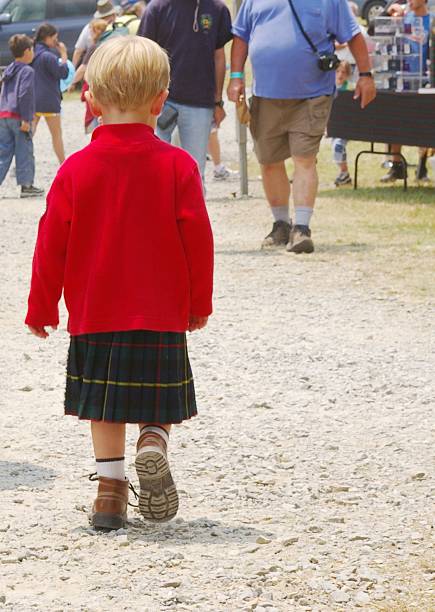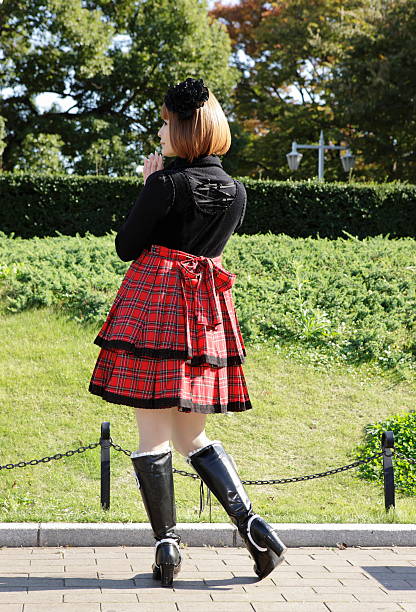Celtic culture and the origins of kilts
Step into the enchanting world of Celtic culture, where traditions and symbolism intertwine to create a rich tapestry of history. Within this vibrant tapestry lies the fascinating story of women’s kilts – an iconic garment that not only embodies the essence of Celtic heritage but also celebrates the power and beauty of femininity.
In this blog post, we will delve into the origins, styles, and symbolism behind women’s kilts in Celtic culture. Get ready to be captivated by a journey through time as we explore how these timeless garments have evolved from ancient rituals to modern fashion statements. So grab your tartan shawl and let us embark on an adventure that pays homage to the incredible legacy of women’s kilts in Celtic lore!
Women’s role in Celtic society and their attire
Women played a significant role in Celtic society, and their attire reflected their importance. In Celtic culture, women were revered as warriors, healers, and spiritual leaders. They enjoyed more freedom and rights compared to other ancient societies.
Celtic women had a distinct style of clothing that emphasized both beauty and functionality. The traditional dress for women consisted of a long tunic called a léine, often made from wool or linen. This garment was usually dyed in vibrant colors like red, blue, or green.
To complete their ensemble, Celtic women wore cloaks known as brat or mantle. These garments provided warmth during the harsh winters while also serving as symbols of social status.
In addition to tunics and cloaks, Celtic women also wore jewelry to adorn themselves. Brooches made from silver or bronze were commonly worn to fasten the layers of clothing together.
The attire of Celtic women not only served practical purposes but also carried symbolic meanings. The use of bright colors symbolized vitality and energy within the community. Additionally, patterns woven into fabrics represented different elements such as nature, spirituality, or family lineage.
Today’s modern adaptations have brought back the popularity of Celtic-inspired fashion for women. Kilts are no longer restricted solely to men; they have been reimagined with feminine touches while still honoring tradition.
In conclusion, the role of women in Celtic society was multifaceted and crucial for its survival and prosperity.Through their attire choices,the Celts celebrated femininity,power,and connection with nature.
The symbolism behind these garments added depth to each piece.Women’s kilts continue to be relevant today,fusing tradition with contemporary fashion trends.While controversies may arise regarding gender roles,the recognition and celebration of Celtic culture should always include appreciation for the contributions made by all genders across history
The traditional kilt for women – style, fabrics, and colors
The traditional kilt for women has its own unique style, fabrics, and colors that reflect the rich Celtic culture. Unlike the men’s kilts which are typically knee-length, women’s kilts are often longer, reaching below the knee or even ankle-length. This adds an elegant touch to their attire.
When it comes to fabrics, natural materials such as wool and tartan are commonly used in women’s kilts. These provide both comfort and durability while staying true to tradition. The intricate patterns of tartan designs allow each woman to showcase her clan affiliation or regional identity.
Colors also play a significant role in women’s kilts. Traditional shades like earthy greens, deep blues, warm reds, and vibrant yellows can be found in various combinations on these garments. Each color holds symbolic meaning within Celtic culture; green represents nature and fertility while blue signifies loyalty and wisdom.
Women often accessorize their kilts with brooches or sashes made from luxurious materials like silk or velvet. This adds a touch of femininity and sophistication to their overall look.
In modern times, designers have adapted the traditional kilt for women into more contemporary styles while still maintaining its essence. We now see mini-kilts paired with tights or leggings for a chic twist on this classic garment. Additionally, different cuts and fits cater to individual preferences without compromising on authenticity.
Women in Celtic culture have embraced the kilt not only as part of their heritage but also as a form of self-expression and empowerment. It embodies strength, resilience, and pride – qualities that resonate with modern-day women across all walks of life.
So next time you spot a woman wearing a kilt adorned with vibrant patterns or subtle hues reminiscent of ancient traditions – take note! She is paying homage to her roots while embracing her own individuality through this timeless piece of clothing.
The symbolism behind the patterns and designs on women’s kilts
The patterns and designs on women’s kilts in Celtic culture hold deep symbolism, reflecting the values and traditions of this ancient society. Each intricate pattern tells a story, weaving together history, mythology, and spirituality.
One common symbol found on women’s kilts is the Celtic knot. These interlocking patterns represent eternity and interconnectedness. They convey a sense of unity with nature and emphasize the cyclical nature of life.
Another significant design element is the spiral motif. Spirals are believed to symbolize growth, transformation, and journeying through life’s cycles. They reflect the ever-changing nature of existence while reminding us that we are part of a larger cosmic order.
Animal motifs also play an essential role in Celtic kilt designs for women. Animals such as wolves, birds, horses, or stags often adorn these garments. Each animal has its own symbolic meaning; for example, wolves represent loyalty and protection while birds signify freedom and spiritual connection.
In addition to these symbols, color holds significance in Celtic culture as well. Earthy tones like green symbolize fertility and rebirth; blue represents wisdom and clarity; red signifies passion and courage; yellow embodies happiness and enlightenment.
These symbolic elements not only add beauty to women’s kilts but also serve as reminders of their rich cultural heritage. Wearing them allows individuals to connect with their ancestral roots while honoring the traditions passed down through generations
Modern adaptations of women’s kilts in fashion and everyday wear
Modern adaptations of women’s kilts in fashion and everyday wear have breathed new life into this traditional Celtic garment. Today, women’s kilts are not just limited to formal occasions or cultural events; they have become a stylish and versatile choice for everyday wear.
In terms of style, contemporary women’s kilts often feature updated silhouettes that cater to the modern woman’s tastes and preferences. They come in various lengths, from mini to midi, allowing for different styling options. Some designs incorporate asymmetrical hemlines or pleated details to add a touch of uniqueness.
When it comes to fabrics, there is now a wide range available for women’s kilts. While traditional tartans made from wool are still popular choices, modern adaptations also include lightweight materials such as cotton or linen blends. These lighter fabrics make the kilt more comfortable for daily wear while maintaining its distinct look.
Colors have also evolved beyond the classic earth tones typically associated with Celtic culture. Women can now choose from an array of vibrant hues that suit their personal style and make a bold fashion statement. From rich jewel tones to pastel shades, there is no shortage of options when it comes to color selection.
Designers and brands have played around with patterns and motifs on women’s kilts as well. While traditional tartan patterns remain timeless classics, contemporary designs may incorporate elements like floral prints or geometric shapes for a modern twist.
Perhaps one of the most significant changes in modern adaptations is the way women style their kilts in everyday outfits. It has become common to see women pairing their kilts with casual tops like t-shirts or sweaters instead of strictly adhering to formal dress codes. This versatility allows them to express their individuality through creative combinations and experiment with different looks.
The modern adaptation of women’s kilts speaks volumes about how fashion evolves while paying homage to tradition simultaneously.
Their incorporation into everyday wear shows that these garments hold significance not only in Celtic culture but also as a symbol of empowerment and self-expression for women around the world.
Controversy surrounding gender roles and kilts in Celtic culture
Controversy surrounding gender roles and kilts in Celtic culture has been a topic of discussion for many years. While kilts are often associated with men, there is evidence to suggest that women also wore them in ancient Celtic society. However, the perception of kilts as solely masculine attire has led to debates about appropriate gender roles and cultural appropriation.
Some argue that women wearing kilts today is a way of reclaiming their place in history and challenging traditional gender norms. They see it as a symbol of empowerment and equality, highlighting the strength and independence of Celtic women throughout time.
On the other hand, some critics believe that adopting traditionally male clothing undermines femininity or dilutes its significance. They argue that preserving distinct gender roles is important for maintaining cultural traditions and identity.
The controversy extends beyond just the act of wearing a kilt; it delves into broader discussions about societal expectations and stereotypes related to gender. It raises questions about how we define masculinity and femininity, as well as who gets to decide what is appropriate attire for each gender.
Whether women choose to wear kilts or not should be an individual decision based on personal expression rather than societal constraints. Embracing diversity within our cultural heritage allows us to celebrate the richness and complexity of Celtic culture without limiting anyone’s freedom or self-expression.
Conclusion: Women’s kilts in Celtic culture
The rich tapestry of Celtic culture is woven with traditions, symbols, and stories that have stood the test of time. Amongst these cherished customs is the wearing of kilts, which hold a special place in both men’s and women’s attire. While kilts are often associated with men in popular imagination, it is important to recognize and celebrate the significant role that women have played in Celtic society.
Women’s kilts have their own unique style, fabrics, colors, patterns, and designs that reflect the intricate beauty of Celtic heritage. The traditional kilt for women embraces elegance while honoring cultural authenticity. Whether made from tartan or plaid fabric or adorned with embroidery or lace details, these garments exude grace and sophistication.
Beyond their aesthetic appeal lies a deeper symbolism ingrained within each fold and pattern on a woman’s kilt. Each design represents different clans or families who proudly wore their distinctive tartans as badges of honor. These patterns also symbolize unity among kinship groups within Celtic communities – a testament to the strength and resilience exhibited by generations past.
In modern times, women’s kilts continue to evolve as fashion adapts to contemporary trends while still paying homage to tradition. Designers experiment with different lengths, cuts, materials, and accessories to create innovative interpretations that cater to diverse tastes and preferences.
However, this evolution has not come without controversy surrounding gender roles within Celtic culture. Some argue that certain aspects of traditional dress should be exclusively reserved for one gender or another based on historical conventions. Others advocate for individual freedom in self-expression through fashion choices regardless of societal norms.
Regardless of differing viewpoints on gender roles within Celtic culture today, we can all appreciate the intrinsic value held by women’s kilts throughout history. They serve as tangible reminders of our shared heritage — an invitation to explore our roots while embracing cultural diversity.











